In Michigan, you can find dramatic sand dunes, remote islands, and lush wetlands along the Great Lakes shoreline. Plants and animals such as tree frogs depend on these transitional areas between land and water.
Although Michigan has only a small variety of tree frogs, they play a vital role in Michigan’s ecosystem. There are eight different species of tree frogs that can be found in Michigan.
If you’re wondering which tree frogs you’ve come across during your ventures across Michigan, read along as I’ll try to describe which species of frogs can be found across the state, along with their distinctive features, so that you can identify them confidently.
Where do tree frogs in Michigan live?
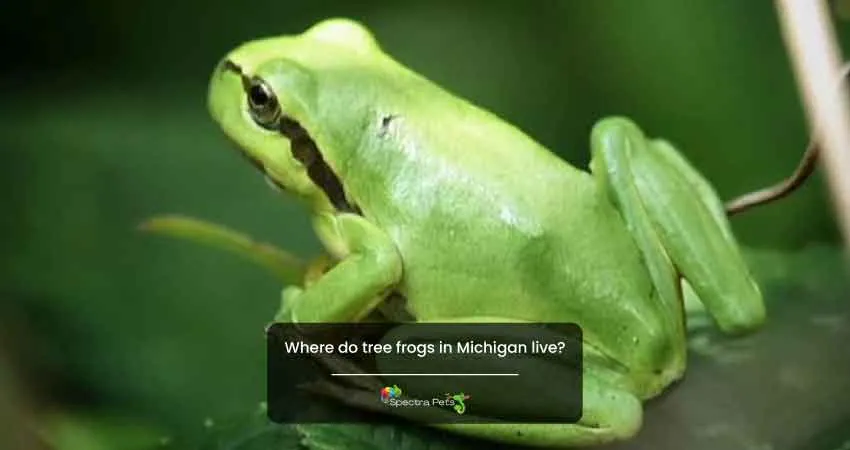
Tree frogs are arboreal creatures. Species that are arboreal have trees as their primary habitat. Not all tree frog species, though, are arboreal. They are also typically found close to bodies of water, particularly following rain.
Tree frogs in Michigan prefer to live in wooded areas that are close to bodies of water.
Tree Frogs in Michigan
As was previously mentioned, there are eight distinct species of tree frogs in Michigan. Below is a list of these frogs:
- Eastern Gray Tree Frog
- Blanchard’s Cricket Frog
- Cope’s Gray Tree Frog
- Northern Spring Peeper
- Boreal Chorus Frog
- Western Chorus Frog
- Wood Frog
- Northern Leopard Frog
What does a tree frog look like in Michigan?
Various tree frogs look different according to their species. Some are bigger, while others are smaller, and they also come in very different colors.
Here’s a short description of each of the species mentioned above, including their scientific name, longevity, and size:
#1 Eastern Gray Tree Frog

| Family | Hylidae |
| Scientific Name | Dryophytes verticolor |
| Longevity | 7 to 9 years |
| Size | 1.25 to 2 inches |
Michigan houses two different types of tree frogs: the Eastern Gray Tree Frog and the Cope Gray Tree Frog.
The distinctive ability of eastern gray tree frogs to change their body hues from green to gray and even to brown gives them the ability to blend into their surroundings. Depending on what they are resting on, their color will change. However, unlike chameleons, the color doesn’t change as fast.
Males have a brown, gray, or black throat. This is particularly noticeable during the breeding season, and females typically have a white throat and do not call.
Eastern gray tree frogs are small in size and can grow up to two inches in length. Females tend to be bigger than males.
With the exception of the breeding season, when they migrate to freshwater, these frogs are only occasionally seen on the ground. They are found in forests and inhabit trees.
The call is the only difference between the Cope’s gray tree frog and the common gray tree frog. The temperature has a direct impact on call rates. Gray tree frogs have pulse rates of up to 34 per second.
#2 Blanchard’s Cricket Frog
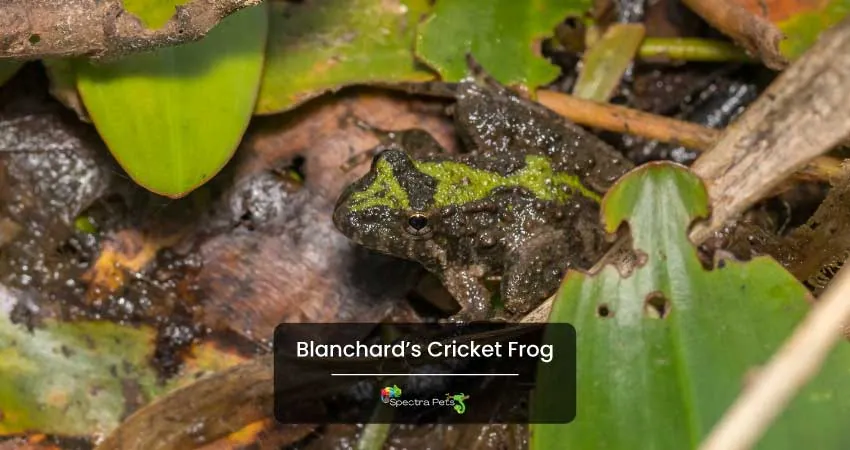
| Family | Hylidae |
| Scientific Name | Acris blanchardi |
| Longevity | About 4 months |
| Size | 0.6-1.5 inches |
The Blanchard’s cricket frog is extremely popular in Michigan. They are regularly found nearby permanent water sources, such as lakes, streams, rivers, and ponds.
These tree frogs have a broad light stripe running down the middle of their backs and are tan, olive, brown, or gray in color with green, black, or red patterns. Additionally, they have two light patterns that form a dark triangle between the eyes and extend from the jaw to the eye. The skin of these tiny frogs is warty.
#3 Cope’s Gray Tree Frog
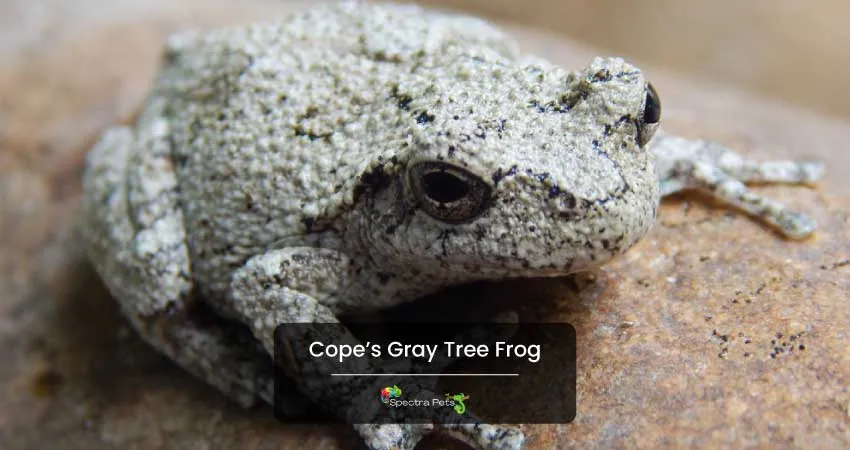
| Family | Hylidae |
| Scientific Name | Dryophytes Chrysoscelis |
| Longevity | 7 to 9 years |
| Size | 1 to 2 inches |
Swamps, mixed forests, suburban areas, and yards with lush vegetation are all good places to spot the Cope’s Gray Tree Frog. They live in areas where there are freshwater sources and lots of cover from bushes and trees.
The background color of this frog is either brown or gray with a few dark patches, and it can change color over the course of an hour or more. They have a white square patch under each eye. There is a dark band that runs from the eye to the frog’s leg.
The call of Cope’s gray tree frogs lasts for about 30 seconds. It has a trill pulse rate and is very melodic, repeating every few seconds.
Males call during the breeding season while hiding in vegetation near freshwater.
#4 Northern Spring Peeper
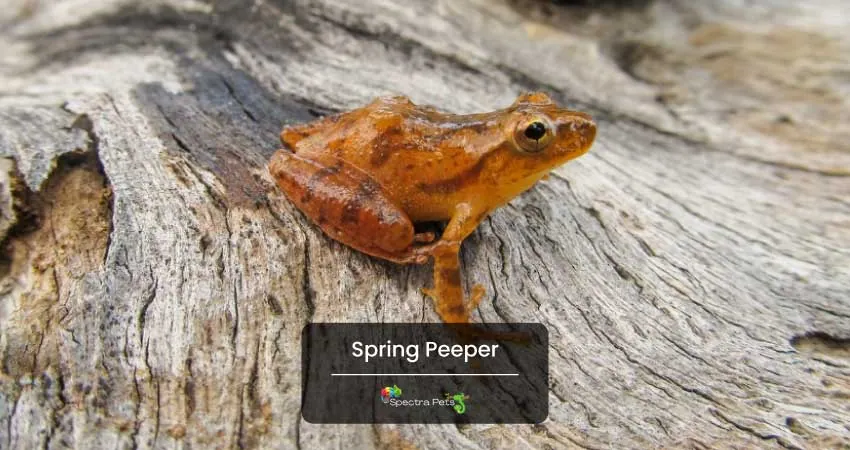
| Family | Hylidae |
| Scientific Name | Pseudacris crucifer |
| Longevity | 3-4 years |
| Size | ¾ to 1¼ inch |
During the breeding season, spring peepers reside in both permanent and transient water bodies. They migrate to woodlands and grassy areas after that.
This species has a dark X on their back. There is a V-shape between their eyes. It is tan, gray, or brown in color. It has a white-ish belly with a yellow groin and bottom of the legs.
Males call with a loud “peeeeeep” that they emit once every second. They are typically smaller and darker than the females. Additionally, they frequently make a whistling sound to alert other males when they approach another male’s territory.
These frogs are very rarely seen. They can be seen more commonly from November to April, because of rain and overcast sky.
Spring peepers are insectivores by nature.
They have a whistle-like high-pitched peeeep that is audible from a long distance. These amphibians produce loud choruses that resemble sleigh bells.
#5 Boreal Chorus Frog
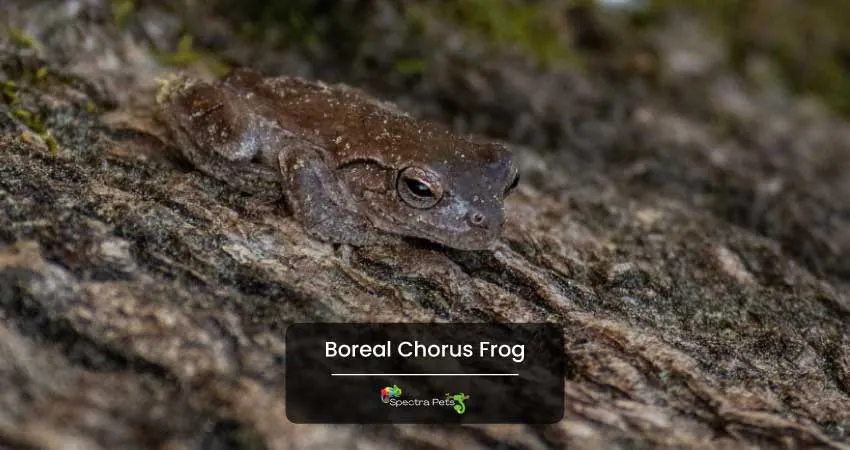
| Family | Hylidae |
| Scientific Name | Pseudacris maculata |
| Longevity | 2-3 years |
| Size | 0.75-1.5 inches |
The boreal chorus frog is a diminutive amphibian that grows to a length of about three centimeters.
It has three distinct or barely perceptible stripes and is typically brown, though it can also be green. It has a dark band that runs down the side, across the eye, and over the snout.
This frog frequently inhabits areas with cleared land and vegetation that are near perennial freshwater bodies of water.
Males often make a “reeeeeeek” noise as a call, which is audible in the grass and vegetation near the water.
These amphibians reproduce in the months of April to September. Their cries alert other males and draw attention from females. Every single one of these frogs has a unique call and pulse pattern.
These frogs’ two-second raspy call is characteristic of their species. It’s like running your fingernail over the teeth of a comb. Some of these frogs have the ability to direct their calls, drawing in as many females as possible.
#6 Western Chorus Frog
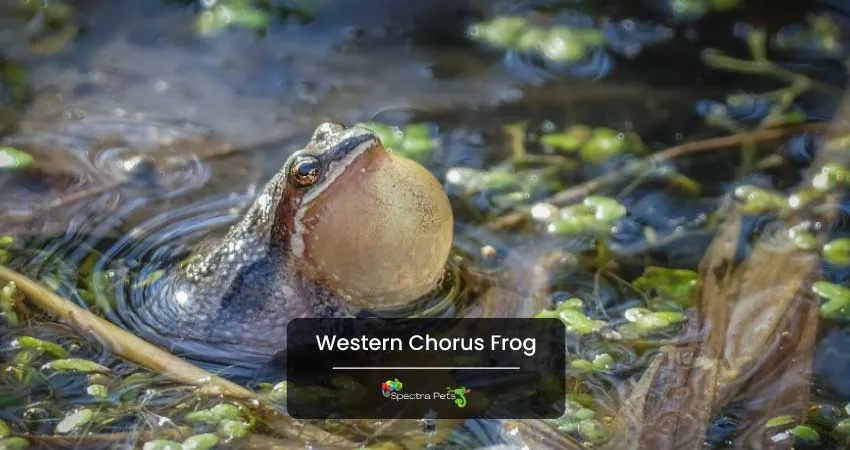
| Family | Hylidae |
| Scientific Name | Pseudacris triseriata |
| Longevity | 4-5 Years |
| Size | Up to 2 inches |
The Western Chorus Frog is a frog that inhabits vernal ponds that are not very deep, marshes, and areas close to swamps. This frog is similar to the Northern Spring Peeper, but there are parallel stripes on its back.
Pet owners may find the males’ high-pitched calls distracting during the breeding season. It makes a sound like a thumbnail brushing against a plastic comb’s teeth. These frogs’ choruses are generally louder in the daytime and can extend into the night.
These small frogs have a diet of small invertebrates.
#7 Wood Frog
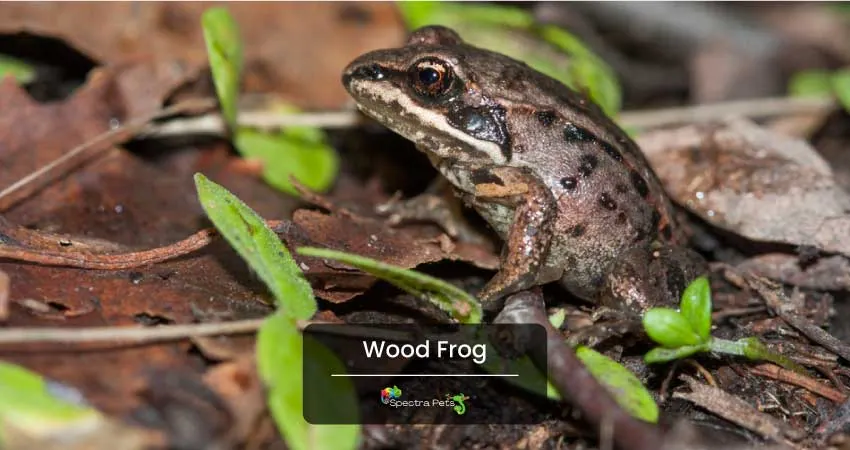
| Family | Ranidae |
| Scientific Name | Lithobates sylvaticus |
| Longevity | 4-5 years |
| Size | 1.4 to 3.5 inches |
The Wood Frog inhabits moist woodlands, such as coniferous, deciduous, and mixed forests. It can, however, also endure cold and icy environments. It’s one of Michigan’s most prevalent poison frogs.
Glucose in its body cells protects it from freezing. Even if a third of its body fluids were frozen, this frog could survive.
Insects and small invertebrates are the primary prey of wood frogs, which are nocturnal. There are however many predators that they must contend with, including bigger frogs, snakes, raccoons, skunks and snakes. In order to survive, they have developed an anti-predator defense system.
To start, they can camouflage themselves to evade predators. Furthermore, their poison glands deter predators as well. When caught, they also let out a piercing, sharp cry that frightens the predator and causes it to release the prey.
#8 Northern Leopard Frog
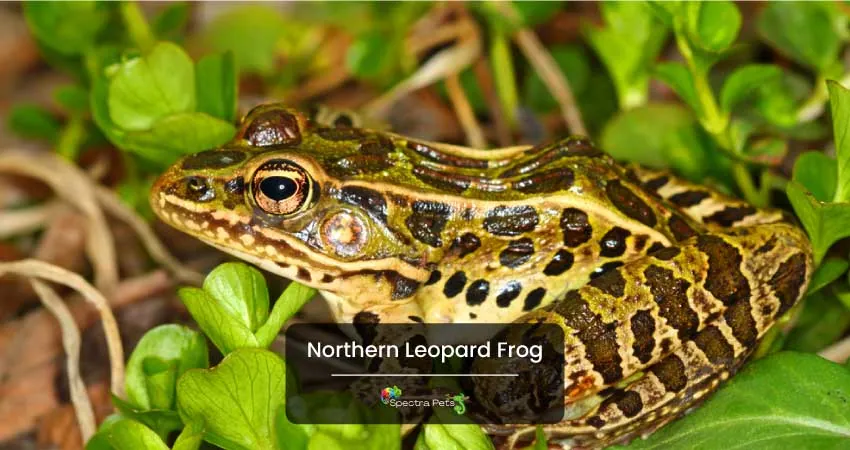
| Family | Ranidae |
| Scientific Name | Lithobates pipiens |
| Longevity | 2–4 years |
| Size | 2 to 4.5 inches |
The Northern Leopard Frog can be found in densely forested areas, grasslands, or close to marshes and ponds. They have a carnivorous appetite. They wait for their prey to come within striking distance before leaping and snatching them with their long, sticky tongues.
A variety of species also prey on these frogs. They are preferred by raccoons, birds, snakes, larger frogs, foxes, and humans because they do not expel toxic skin secretions.
These frogs are active from March to June. To entice females, males emit rumbling calls that resemble snoring. The females can produce up to 6,500 eggs following mating.
Are Michigan tree frogs poisonous?
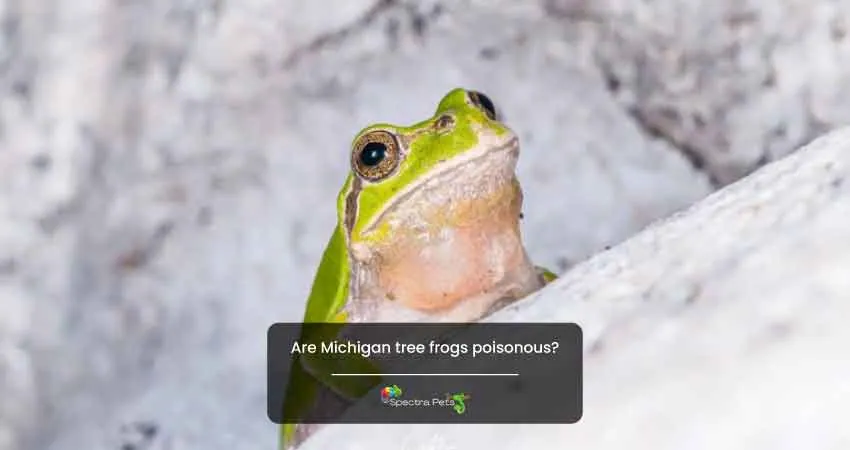
The wood frog is the only poisonous variant found in Michigan. As long as you inform yourself well enough about this one particular species, you should be able to avoid any intoxication from frogs. If you spot wood frogs in a larger group, contact your local wildlife commission immediately.
Wrapping Up
Frogs play a crucial role in maintaining the coastal ecosystem of Michigan despite not having a wide variety here. The Blanchard’s cricket frog is the most loved variant amongst pet owners.
In Michigan, tree frogs are not particularly poisonous, with the exception of wood frogs, which you need to be wary of.
Sometimes you can spot a large number of frogs around your household, and in such cases, you should let the authorities take the necessary measures.
Tree Frogs Found in the Nearby States of Michigan:
